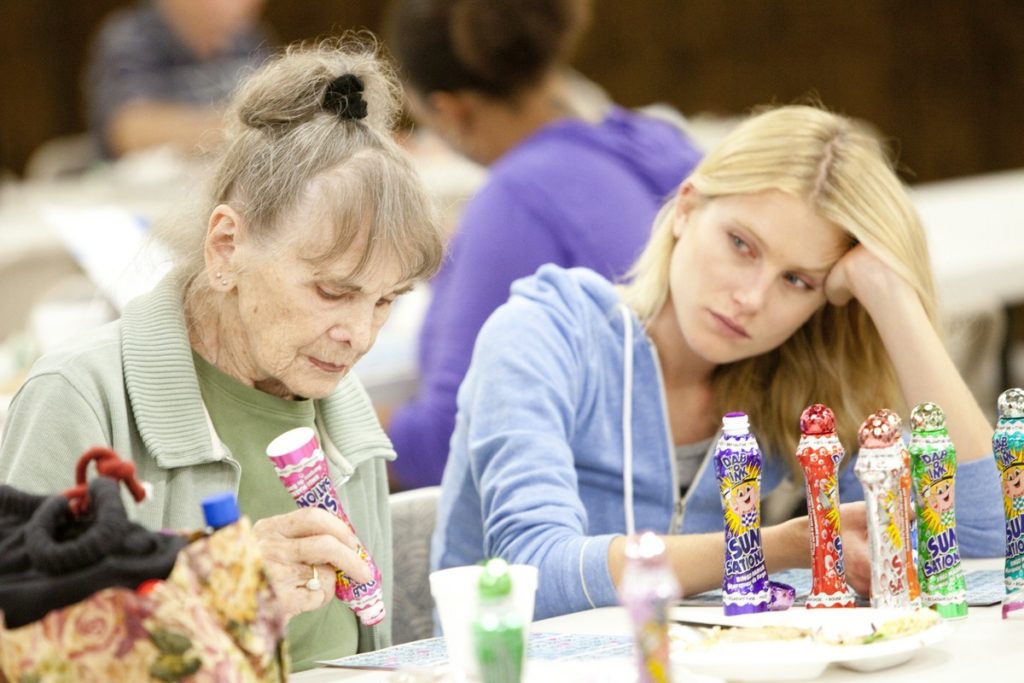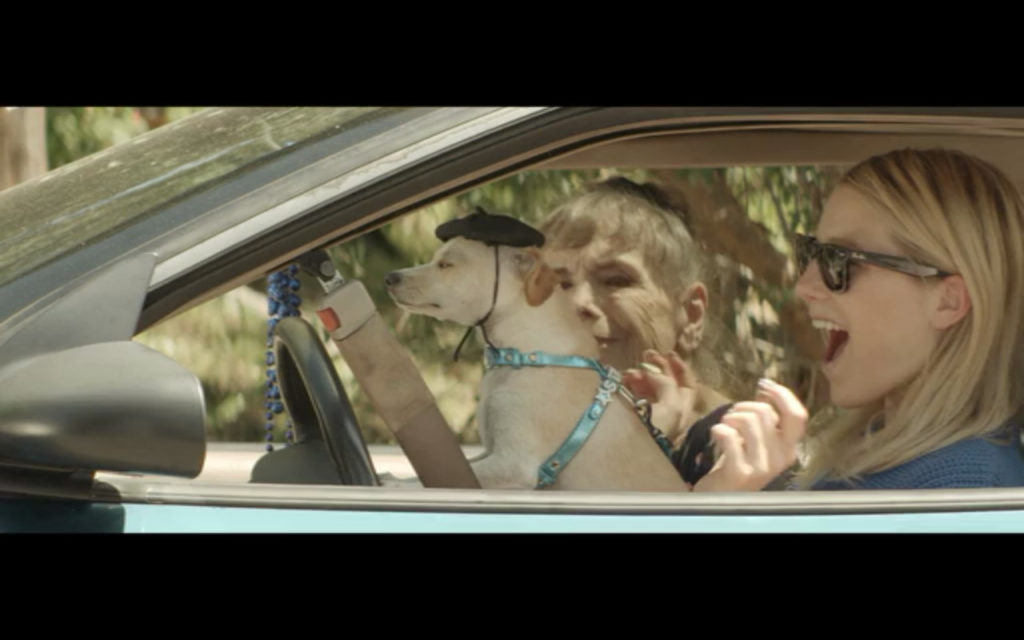
EDITOR’S NOTE: In case you didn’t catch the byline, this is a guest post! Please enjoy this piece from a writer whose work I am thrilled to feature (because I love reading her work elsewhere): Veronica Phillips.
For Starlet’s twenty-something year old protagonist Jane (Dree Hemingway), conventional understandings of intimacy regarding sex, love, friendship, and connection certainly exist and matter, but they are altered by both her line of work and the general sense of loneliness that comes from the early stages of learning to live as an individual and an adult. Notions of traditional value systems of monogamy, nuclear families, socially-approved-of work, and creating a home are not what currently center Jane’s life (nor does she seem to long for them). Instead, Jane lives in Los Angeles, a city notorious for its almost built-in loneliness, in a shitty apartment with some friends – a young couple named Melissa (Stella Maeve) and Mikey (James Ransome). Jane looks like she’s been pulled directly out of a 2012 American Apparel ad. She’s bleach-blonde, dressed in tiny plain tees and short-shorts, often paired with those thigh high, striped tube socks that were so en vogue in the early 2010s. She spends a lot of her day smoking weed and hanging out, always with her tiny, precious rescue dog, Starlet, in tow. Jane has a mother who she claims is hooked on oxys and presumably lives where Jane used to live, in Jacksonville, Florida; while Jane tries to coax her mother to come visit her, Jane’s mother seems generally disinterested in their relationship.
Perhaps the most distinct contrast in Jane’s life regarding love, sex, and intimacy, however, stems from her line of work. For much of Starlet, we are not told what Jane does for a living, but depending on how versed one may be in the porn industry and the fact that one of its major hubs is in the San Fernando Valley, some may catch on faster than others. About forty-five minutes into the film, Jane arrives at a shoot, and we get a definitive and explicit explanation of her work. She and porn superstar Manuel Ferrera have non-simulated oral and penetrative sex on camera (with Hemingway being body-doubled by adult film actress Zoe Voss for the shots of non-simulated sex, a common Google search regarding the film).
I preface with this description of Jane’s life and work not because I find Starlet’s presentation of sex work and porn to be its most interesting aspect, nor to critique its representation in the film. There is a sort of matter-of-fact neutrality regarding the porn industry in Starlet, described succinctly in Roger Ebert’s review as a “strictly-for-business,” “mechanical” process.
Instead, I preface with this description simply because it encapsulates the way that intimacy as we would conventionally conceive of it, especially in forcing strict, morally-coded value systems upon certain kinds of romantic and sexual relationships, is not and cannot be a concern for Jane because of her job in the sex industry. She has friends, she has moments of closeness, but she also admits (in a rather nonchalant, unbothered way), that romance is not as much of an option because of her line of work. She spends a fair amount of time alone, driving around or sleeping in the small, barren room for which she pays $1,200 a month.
For Starlet’s eighty-something year old Sadie (Besedka Johnson), intimacy has been long removed from her life. Her husband, Frank, has been dead for decades, she gave up her driver’s license when she decided she was officially “too old” to have it, and her one recreational activity is Bingo on the weekends. Otherwise, she sits at home, or has a taxi cab drive her to the grocery store or Frank’s headstone.
Jane and Sadie’s relationship begins over an old, ornate Thermos that Sadie is selling in a yard sale. After buying it, Jane discovers that the Thermos is stuffed with cash, about ten thousand dollars worth. At first she does what I assume many of us would — getting her nails done, buying some new clothes and a special, bedazzled harness for her dog — but her conscience begins to weigh on her quickly. After a failed attempt to return the money, Jane begins orchestrating meet-cutes and run-ins with Sadie in hopes of accumulating enough acts of kindness that she can no longer feel guilty about the matter.
From the moment they meet, the two women are in conflict, bickering over how Jane is going to use the Thermos (she insists it’ll work as a vase, which deeply offends Sadie’s by-the-book mentality). Their basic understandings of relationships clash. Jane fails to respect Sadie’s repeated requests to be left alone, insisting on driving Sadie home from the grocery store and showing up to her weekly Bingo sessions to sit next to her. Sadie is unfairly suspicious of Jane, certain that she is being “scammed” by the younger woman.
And yet, in spite of this constant bickering, this push-and-pull, once Jane and Sadie have met, they simply cannot seem to detangle from each other’s orbits. As Jane continues to insist on helping, and Sadie consistently, yet begrudgingly, needs help, the early reasons for these acts of kindness become blurred.

In fact, soon after meeting, Jane and Sadie begin hanging out just because they want to. Jane wants to see Sadie, waking up at 7:30 AM for breakfast with her, rushing to get out of her make-up from a shoot to pick Sadie up from the grocery store, aggressively defending Sadie against some insurance providers. And Sadie, at first blunt and seemingly disinterested in Jane’s attentions, begins telling Jane about her past, buying Starlet treats at the store, and asking Jane about her love life. Gradually, the two stop resisting the strangeness of the situation, and start genuinely loving each other. Their relationship blossoms during little dates to the dog park, on drives to errands, on a trip to the place where Sadie’s husband proposed to her. Jane and Sadie, in their private worlds where love and intimacy work differently than the average person, develop, in an unexpected and delightful sense, into each other’s soulmates.
Jane provides Sadie with someone to connect with without having to change who she is, while Jane, on the other hand, is provided a relationship outside of her somewhat tumultuous living situation and the transactional nature of her work. And while we never know for certain if Sadie knows what Jane does, one gets the sense that she wouldn’t really care. It doesn’t affect the basic tenets of their relationship – that of simple, authentic time together.
Perhaps the most endearing part of Jane and Sadie’s relationship, however, is that they remain unchanged by each other. They are soulmates because of their differences, because of their endless bickering, because of the way they do not feel pushed to share every aspect of their personal lives with one another. The two never stop having little arguments. Sadie doesn’t stop being crotchety, and Jane doesn’t stop being young and idealistic. Their gestures of love are a heartwarming part of their growing affections for one another, but their soulmate-ness comes from their willingness to just let the other be. Neither one makes drastic changes to herself to become more palatable to the other. The bickering and the messiness and the difference is welcome, and it’s what makes their connection so strong.
Their various reciprocal loving gestures eventually culminate with Jane spending the remainder of Sadie’s found money on a luxury trip to Paris for the two of them, hoping to fulfill one of Sadie’s lifelong dreams. Right before they leave, Melanie — stung by the fact that she was denied the acts of care that Jane is showering on some presumably random old woman — drives to Sadie’s house to tell her the truth: that Jane has been spending time with Sadie out of guilt for stealing the money.
But Sadie is unbothered by this revelation. In fact, this attempt at destroying Sadie and Jane’s love is what brings their soulmate-ness to its most tangible, solidified form. In the final moments of the film, Sadie asks Jane to stop at the cemetery on the way to the airport to drop flowers off for her husband, Frank. This is one of their regular errands, but this time, Sadie asks for Jane to go up to Frank’s headstone instead of her.
In the warm, golden Los Angeles sunshine, Jane stares down at not one, but two headstones; Sadie did not just lose a husband, but lost a teenage daughter. Jane looks up, overcome, and locks eyes with Sadie studying her from the car. They gaze at each other in silence, like lovers finally seeing each other, or like daughter seeing full, complicated mother. And yet, they are like neither of these things, because Jane and Sadie’s love holds a magic that goes beyond the romantic and the maternal. It’s something beyond blood or want, it just is. In Sadie’s vulnerability, in her revealing of this loss, she gives Jane everything – forgiveness, full and total acceptance, and a revelation of an indescribably painful loss. She trusts Jane with all of this. The money could not be more irrelevant to her. Jane is well worth losing that ten thousand dollars, just like giving that money back to Sadie in the form of a dream trip is well worth it to Jane.
Jane walks back to the car and looks outward at the world, her life shifted. She opens the door to get in, and Starlet ends. Jane and Sadie understand intimacy differently than the average person — but I think we all do. What’s an average person’s version of intimacy? Is there such a thing? Starlet invites us to open ourselves up to the opportunity of true love taking on forms beyond the limited ways we are asked to picture love and life and connection.
We don’t see Jane and Sadie pull off into the sunset. We don’t hear what is said or isn’t said after this revelation. We don’t need to see those things. We know that Jane and Sadie are meant to be together, we know that they will see and hear each other in a way that no one one else sees or hears. They will continue being exactly what they are, and being loved unconditionally by each other for it.
